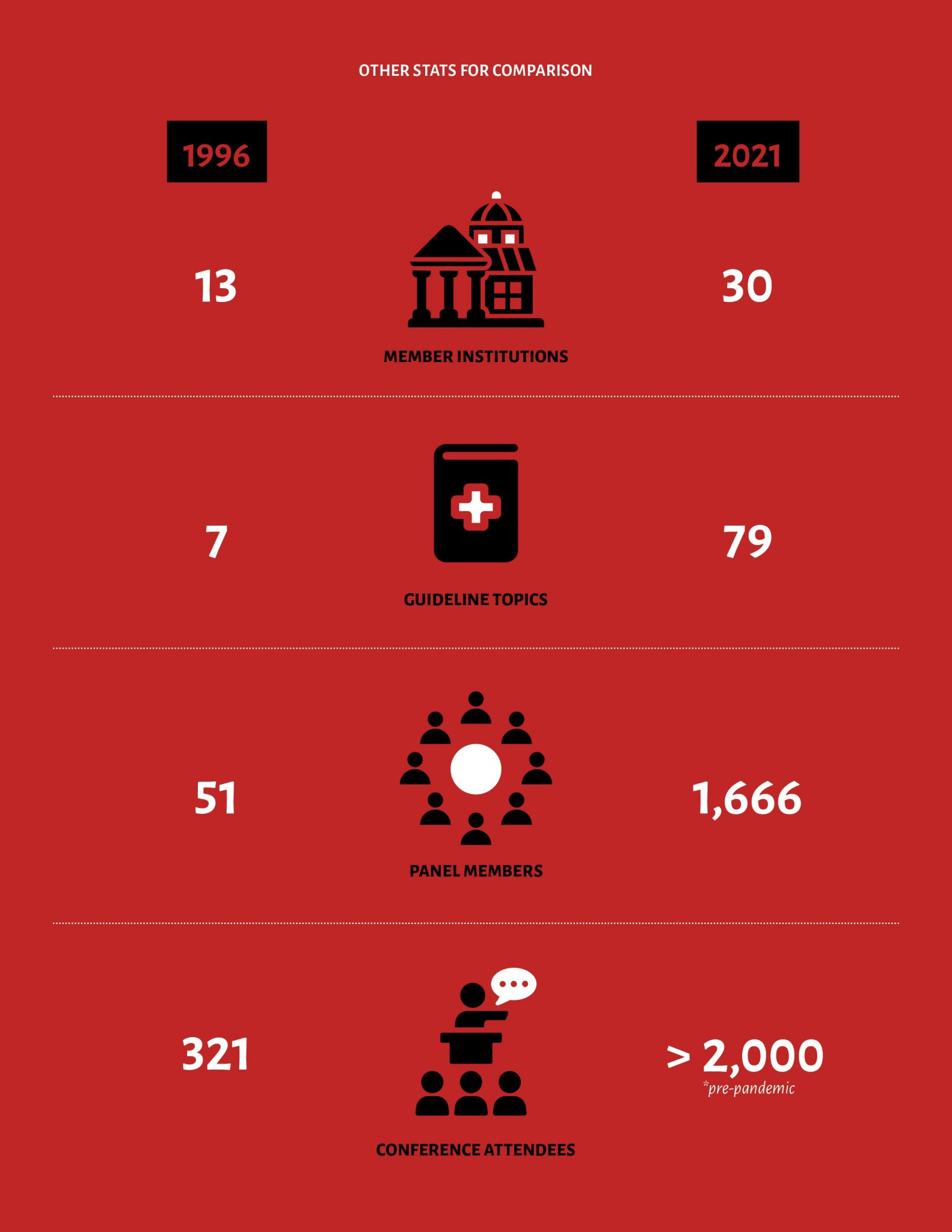A quarter century ago, on March 3, 1996, in Ft. Lauderdale, the National Comprehensive Cancer Network held a conference—its first.
Broadly stated, the goal was to engage 13 of America’s elite cancer centers into developing an approach to pricing and measuring outcomes in cancer care.
I was there: “Centers Network Release ‘Version 1.0’ Of Clinical Guidelines for Eight Cancers” (The Cancer Letter, March 15, 1996).
NCCN’s goal was to transform oncology into a scientific enterprise guided by standards, as opposed to a domain of luminaries who purport to understand the mysteries of cancer. Since that debut, NCCN has been promulgating guidelines based on standards of care provided at academic institutions and making these guidelines available to community oncologists and the public.
The organization’s guidelines are used in payment decisions by the government and insurers.
Over the next three weeks, Cancer History Project will publish interviews with:
- Robert C. Young, founding vice chairman of the NCCN board,
- William T. McGivney, CEO from 1997 to 2012,
- Robert W. Carlson, CEO since 2013.
In 2012, I wrote a detailed recap of NCCN history. At the time, nearly a decade ago, memories were fresher, making it possible to write a more granular story that cannot be done today. Two key participants of those events, notably the organization’s second CEO Bruce Ross and the first chairman of the board Joe Simone, have since died.
The entire story is posted here.
The section on guideline writing appears below:
The guidelines format emerges
Disputation is an endeavor in which academics excel.
“The idea was that we used free horsepower—all the docs in these institutions were asked to serve on committees,” Simone recalled. “We didn’t have to pay them. We had to pay the travel, but we didn’t have to pay them. And we could build a reputation for the organization based on having established standards.”
In March 1995, the organization presented guidelines that covered cancers of the breast, colon, prostate and the lung. Also covered were acute leukemia and pediatric cancers.
Altogether, these diseases accounted for 51 percent of all cancers.
Using templates designed primarily by Rodger Winn, chairman of the NCCN Guidelines Steering Committee and an oncologist at MD Anderson at the time, the organization came up with guidelines that were both brief and easy to change.
For example, the most controversial of the guidelines at the time—the first version of the guideline for breast cancer—fit on just 25 pages. The guideline addressed standard—as opposed to investigational—treatments. This allowed the breast cancer committee to avoid a fight over bone marrow transplantation.
“We assumed that investigational care will always take precedence over the guidelines,” Robert Carlson, a Stanford University oncologist who headed the breast cancer panel [and future NCCN CEO], said at the time (The Cancer Letter, March 15, 1996).
The committee didn’t recognize bone marrow transplants as standard practice, and a fight was averted.
The unveiling of the guidelines established the centers as the leading voice in oncology, Simone said.
“It was a hit,” he said. The first meeting of NCCN sent a message to the field: the cancer centers are setting the standards for quality care. The centers would do well by doing good.
“You would send your complex cases there, ones that you couldn’t handle,” Simone said.
“The biggest reason we thought it would help us is that it would give us an opportunity to look at what we were doing,” said Young, who first served as vice chairman of the NCCN board and chairman of the outcomes committee. “We were pretty confident that, measured by our own guidelines of what constitutes state of the art care, we would do reasonably well.
The guidelines were unique in medicine.
“You have guidelines written by state-of-the-art experts in their fields, covering all cancers, updated on the monthly basis,” Young said. “And that doesn’t exist anywhere, and probably couldn’t, with any other group. And it certainly doesn’t exist in any other disease.”
It would be impossible to accomplish this breadth with evidence-based guidelines. Such guidelines “tended to be developed, published, and ended up on shelves gathering dust,” Young said. “And they lacked a number of things we believed were critical. One, they ought to be guidelines that could be read in a very short period of time. Simple guidelines. They ought to build in the capacity for encouraging patients to enter clinical trials.
“And two, they needed to be comprehensive, because it wasn’t very helpful to have one guideline on breast cancer treatment and one on diffuse lymphoma and one on colon cancer—and nothing else.
“I think oncologists realize that if you just used evidence-based medicine, you wouldn’t have guidelines on much of anything. A few in adjuvant therapy, and breast cancer, and colon cancer, and that’s about it.
“We said, ‘Look, we want evidence-based medicine as much as we can use it, we want criteria for the strength of particular recommendations, but we want recommendations of what a group of experts believe is state of the art care that day.’
“The other thing that we built into it early on is the capacity to provide feedback to the institutions. If they found themselves either as a group or individual doctors within their institutions lacking adherence to our own agreed-upon guidelines, they would be encouraged either to conform or explain why the guideline is inappropriate and thereby encourage having it be changed.
“It was a continuous quality improvement strategy.”
NCCN has provided The Cancer Letter and the Cancer History Project comparative data on how the guidelines have expanded from 1996 to 2021—from seven topics to 79 and 51 panel members to 1,666.






NCCN history
November 1993 – NCCN is formally incorporated
January 1995 – NCCN is announced as a national alliance to develop and institute standards of care for the treatment of cancer and perform outcomes research
1995 – Bruce R. Ross leads NCCN as chief executive officer
March 1996 – The NCCN first annual conference is held and attracts 321 attendees
November 1996 – The first NCCN Clinical Practice Guidelines in Oncology (NCCN Guidelines) are published for the following disease types: Acute leukemia and breast, colon, lung, ovarian, pediatric, prostate, and rectal cancers
January 1997 – William T. McGivney, PhD, leads NCCN as chief executive officer
July 1997 – NCCN launches its first database, the NCCN Oncology Outcomes Database for Breast Cancer, at five NCCN Member Institutions
March 1998 – NCCN.org, NCCN’s website for clinicians, launches
May 1998 – The NCCN Treatment Guidelines for Patients are first developed
March 1999 – NCCN establishes what is now known as the Oncology Research Program (ORP)
December 2001 – The first Complete Library of NCCN Guidelines is made available
January 2003 – The first issue of JNCCN–Journal of the National Comprehensive Cancer Network is published
November 2004 – The first NCCN Drugs & Biologics Compendium (NCCN Compendium) chapter is available
September 2006 – The NCCN first Annual Congress: Hematologic Malignancies is held and attracts 365 attendees
May 2008 – NCCN Chemotherapy Order Templates (NCCN Templates) for Bladder, Kidney, and Prostate Cancers and Chronic Myelogenous Leukemia are made available
April 2009 – NCCN launches its first patient site as NCCN.com
July 2009 – NCCN launches its first live webinar program, NCCN Oncology Case Management Program: Non-Small Cell Lung Cancer, attracting over 230 attendees
May 2010 – The NCCN Foundation is created
September 2010 – The NCCN Guidelines for Patients are published
September 2012 – NCCN launches the Virtual Library of NCCN Guidelines for tablet computers
December 2012 – NCCN Biomarkers Compendium becomes available on NCCN.org
January 2013 – Robert W. Carlson, MD, joins NCCN as chief executive officer
June 2013 – NCCN implements NCCN Core Values
July 2013 – NCCN International Educational Activities Program (NCCN IEAP) launches
August 2013 – NCCN launches NCCN Patient and Caregiver Resources at NCCN.org/patients
December 2013 – NCCN launches NCCN Guidelines apps for smartphones
May 2014 – NCCN Guidelines for Patients become available for purchase on Amazon.com
September – December 2014 – NCCN publishes 20th annual editions of original eight NCCN Guidelines
December 2014 – NCCN reaches a record high of more than six million PDF downloads of the NCCN Guidelines from NCCN.org and NCCN Virtual Library of NCCN Guidelines mobile apps.
January 2015 – NCCN celebrates 20th anniversary (view video)
March 2015 – NCCN launches NCCN Framework for Resource Stratification of NCCN Guidelines (NCCN Framework)
October 2015 – NCCN launches NCCN Guidelines with NCCN Evidence Blocks
June 2016 – NCCN launches NCCN Imaging Appropriate Use Criteria (NCCN Imaging AUC)
July 2016 – NCCN accepted as CMS-approved Provider Led-Entity for development of NCCN Imaging AUC
November 2016 – NCCN launches Just Bag It: The NCCN Campaign for Safe Vincristine Handling
November 2016 – NCCN Guidelines for Patients become available in mobile app format
March 2017 – NCCN launches NCCN Radiation Therapy Compendium
March 2017 – The launch of JNCCN 360 is announced during the NCCN 22nd Annual Conference
November 2017 – NCCN launches NCCN Harmonized Guidelines for Sub-Saharan Africa
February 2018 – NCCN and ASCO collaboratively develop guidelines to offer clinicians recommendations for assessment and management of side effects related to immune checkpoint inhibitors.
April 2018 – ORP broadens the free use of the Shared Resource Database to all U.S. cancer centers.
May 2018 – NCCN named Wui-Jin Koh, MD, as its first senior vice president, chief medical officer
May 2018 – NCCN begins work on guidelines to improve cancer care in the Caribbean
August 2018 – JNCCN introduces new associate editors to continue focusing on original research to improve the quality of cancer care
October 2018 – NCCN moves Global Headquarters to Plymouth Meeting, PA
November 2018 – NCCN announces Abramson Cancer Center at the University of Pennsylvania as a New Member Institution
January 2019 – NCCN Guidelines raise standards for cancer care worldwide by exceeding 10 million downloads — up 26% over 2017
May 2019 – NCCN announces the publication of NCCN Guidelines for Pediatric Acute Lymphoblastic Leukemia, the first guideline for a pediatric cancer from NCCN
November 2019 – NCCN, together with American Cancer Society, Clinton Health Access Initiative, and IBM, announced the new alliance, Allied Against Cancer, to continue the efforts to improve access to high-quality cancer care and treatment in Sub-Saharan Africa
January 2020 – NCCN celebrates 25th anniversary
March 2020 – NCCN Announces UCLA Jonsson Comprehensive Cancer Center and UT Southwestern Simmons Comprehensive Cancer Center as New Member Institutions
Source: NCCN












